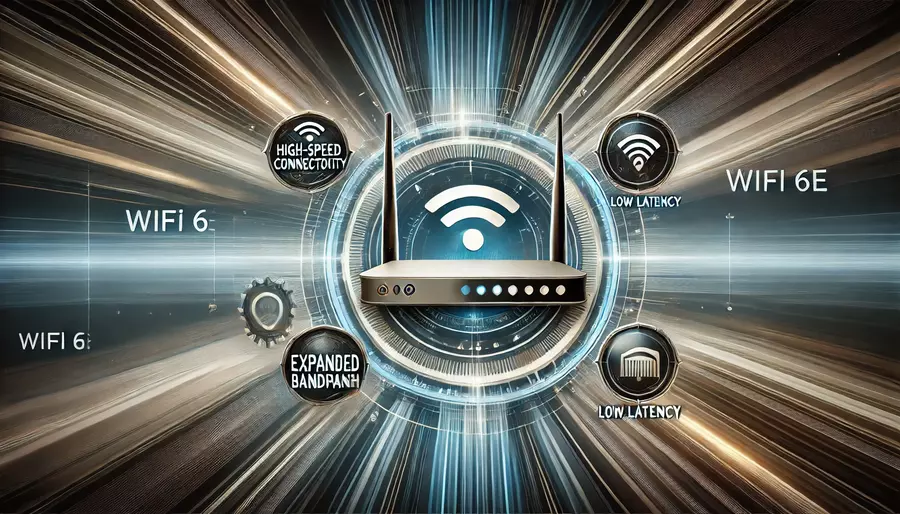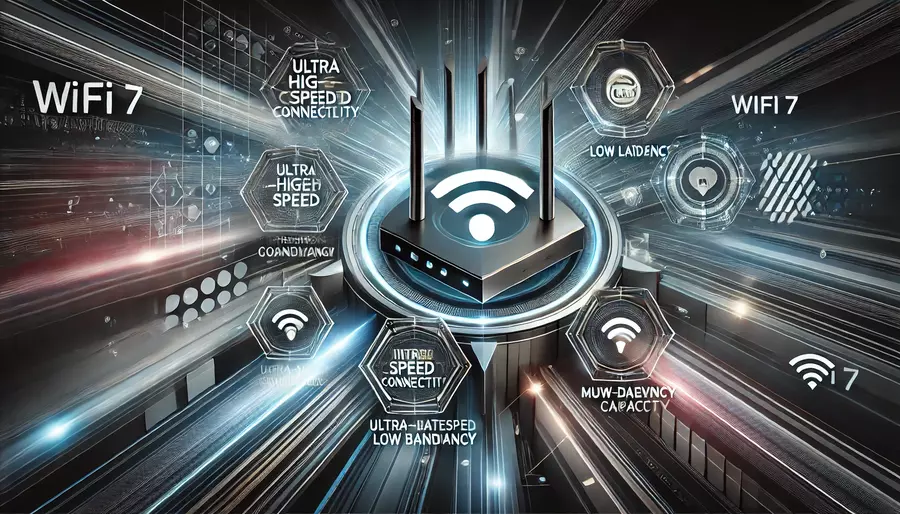EXTENDMAX – WiFi 6E and WiFi 7 are the latest generations of wireless network technology, promising an enhanced internet experience with higher speeds, lower latency, and stronger connectivity. So, what’s the difference between WiFi 6E and WiFi 7? Why should you consider upgrading to these WiFi standards? When will these advanced WiFi standards become available in Vietnam? The following article will help you understand more.

What is WiFi 6E?
WiFi 6E is an extended version of WiFi 6, also based on the IEEE 802.11ax wireless connectivity standard, but with the addition of a 6 GHz band alongside the traditional 2.4 GHz and 5 GHz bands. With this new band, WiFi 6E can offer larger channels, reduce signal interference, and improve device performance. The benefits WiFi 6E brings over previous versions include:
- Higher speed: The 6 GHz band increases data transmission speed, ideal for bandwidth-intensive applications like streaming 4K/8K video.
- Low latency: WiFi 6E better supports low-latency applications, such as online gaming and video conferencing.
- Stable connections: With its ability to reduce network congestion, WiFi 6E performs efficiently in crowded environments with many connected devices.

What is WiFi 7?
WiFi 7, also known as IEEE 802.11be, is the next generation of WiFi with significant advancements in bandwidth and data transmission technology. Compared to WiFi 6E, WiFi 7 supports wider channels (up to 320 MHz) and introduces Multi-Link Operation (MLO) technology, enabling data transmission and reception across multiple bands simultaneously. Key highlights of WiFi 7 include:
- Exceptional speed: WiFi 7 utilizes 4K QAM, significantly boosting data transmission speeds, making it ideal for applications like virtual reality (VR), augmented reality (AR), and industrial IoT systems.
- Ultra-low latency: Thanks to MLO, WiFi 7 minimizes latency, making it perfect for applications that require real-time responsiveness.
- Enhanced scalability: With its wider bandwidth and ability to connect multiple devices, WiFi 7 is well-suited for environments that require large-scale and diverse device support.

Compare WiFi 6E with WiFi 7
Here’s a comparison table between WiFi 6E and WiFi 7 to help you better understand the improvements and features of these two WiFi technology generations:
| Feature | WiFi 6E | WiFi 7 |
|---|---|---|
| Connection Standard | IEEE 802.11ax | IEEE 802.11be |
| Supported Bands | 2.4 GHz, 5 GHz, 6 GHz | 2.4 GHz, 5 GHz, 6 GHz |
| Maximum Channel Width | 160 MHz | 320 MHz |
| Modulation Technology | 1024-QAM | 4K QAM (4096-QAM) |
| Maximum Speed | Up to 9.6 Gb/s | Up to 46 Gb/s |
| Multi-Link Technology | Not supported | Supports MLO (Multi-Link Operation) |
| Latency | Low | Ultra-low |
| Ideal Applications | 4K/8K video streaming, online gaming | VR, AR, industrial IoT, real-time applications |
| Scalability | Well-suited for home and office devices | Ideal for environments requiring multi-device support |
Summary:
- WiFi 6E is an excellent choice for applications requiring high bandwidth, reduced interference, and enhanced speeds, making it ideal for areas with high device density, such as offices and homes.
- WiFi 7 marks a breakthrough in speed and latency, offering greater scalability and real-time responsiveness, especially suited for applications like virtual reality, augmented reality, and industrial IoT systems.
Depending on your needs, you can choose WiFi 6E or WiFi 7 to optimize your wireless network experience.
Should You Upgrade to WiFi 6E or WiFi 7?
If you frequently use applications that require high bandwidth and low latency, such as high-quality video streaming or online gaming, WiFi 6E may be an ideal choice. However, with the constant evolution of technology, WiFi 7 is expected to become the WiFi standard of the future, suited for applications demanding ultra-high speeds and low latency, especially in industrial and automation fields.
Current Context of WiFi 6E & WiFi 7
Today, most internet-connected devices, such as smartphones, laptops, smart TVs, wearables, and IoT devices, come equipped with Wi-Fi, resulting in a steadily increasing demand for connectivity. However, the Wi-Fi bands allowed for use in Vietnam are still limited to 2.4 GHz and 5 GHz, as they were before the 2020s.
Globally, many countries have expanded Wi-Fi bands to meet this growing demand, particularly by adding the 6 GHz band. In Vietnam, devices with WiFi 6E and WiFi 7 capabilities are already available, but current regulations still permit only the 2.4 GHz and 5 GHz bands. Consequently, manufacturers are required to disable the 6 GHz band when operating in Vietnam. While this ensures regulatory compliance, it also limits some of the features and user experiences offered by WiFi 6E and WiFi 7-enabled devices.
>>> See More: Analyzing the Current Context of WiFi 6E & WiFi 7

WiFi 6E and WiFi 7 are not yet permitted for use in Vietnam as of the current time (2024)
When will WiFi 6E & WiFi 7 be available?
In a previous article on WiFi 6E and WiFi 7 by ExtendMax, we outlined the expected timeline for establishing a regulatory framework for the rollout of WiFi 6E and WiFi 7 in Vietnam. Currently, the regulatory updates needed to support this deployment are as follows:
1. Frequency Band Allocation for the 6 GHz Band: Define specific frequency ranges within the 6 GHz band for WiFi and others for 5G NR networks.
-
- Status: Completed. The frequency range allocated for WiFi 6E and WiFi 7 is 5925 MHz ~ 6425 MHz. The remaining portion of the 6 GHz band is expected to be reserved for 5G NR or other emerging mobile technologies.

From 01-July-2025, Vietnamese citizens are expected to be able to use the advanced WiFi 6E and WiFi 7
2. Amendment or Replacement of Circular 08/2021/TT-BTTTT to Include WiFi 6E in the List of License-Exempt Frequencies
-
- Status: The Ministry of Information and Communications (MIC) has issued a draft amendment to Circular 08/2021/TT-BTTTT. View the full draft and provide feedback here: https://mic.gov.vn/van-ban-phap-luat/du-thao/2210.htm.
3. Conformity Certification for WiFi 6E: This could be through a specific technical standard or using existing standards such as QCVN 74:2021/BTTTT or the frequency band standard QCVN 47:2015/BTTTT.
-
- Status: This is expected to be added in an amendment or replacement to Circular 02/2024/TT-BTTTT, with a draft from the MIC anticipated between January and March 2025 and to take effect from July 1, 2025.
Therefore, from July 1, 2025, Vietnamese citizens are expected to be able to use the advanced WiFi 6E and WiFi 7 technologies.
Latest update:
WiFi 6E and WiFi 7 will be officially allowed in Vietnam starting from May 15, 2025, according to Circular 01/2025/TT-BKHCN.
















